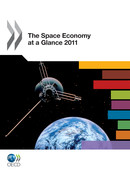Innovation policies for space and oceans (IPSO)
The Space Economy at a Glance 2011
|
Pages: 116 |
Space applications have become an important part of everyday life. Weather forecasting, air traffic control, global communications and broadcasting, disaster management -- these and many other key activities would be almost unthinkable today without satellite technology. The space industry itself is relatively small compared to other manufacturing sectors, but its technological dynamism and strategic significance mean that it plays an ever more critical role in modern society. |
This book assembles information on the space economy from a wide range of official and non-official sources. Together these paint a richly detailed picture of the space industry, its downstream services activities, and its wider economic and social impacts. Who are the main space-faring nations? How large are revenues and how much employment is there in the sector? How much R&D goes on, and where? What is the value of spin-offs from space spending? Answers to these and other questions are provided in this second OECD statistical overview of the emerging space economy.
A dynamic link (StatLink) is provided for graphs, which directs the user to a web page where the corresponding data are available in Excel® format.
For a summary of the key methodological issues surrounding indicators and statistics on the space sector and the larger space economy, see the OECD Handbook for Measuring the Space Economy, published in 2012.
Executive summary
Introduction
Chapter 1. The space sector in 2011 and beyond
- A new world map of space powers
- The space economy as an engine of economic growth
- Preserving a skilled workforce in the space sector
- New technologies and innovative applications on the horizon
Chapter 2. Readiness factors: Inputs to the space economy
- Governmental budgets for space activities
- Capital stocks: Space assets in orbit and on the ground
- Human Capital
Chapter 3. Intensity: Activities and outputs in the space economy
- The manufacturing space industry
- The satellite telecommunications sector
- The satellite Earth observation sector
- Insurance market for space activities
- International trade in selected space products
- Innovation for future economic growth: Patents
- Space launch activities worldwide
- Space exploration activities
Chapter 4. Impacts: Bringing space down to earth
- Defining socio-economic impacts from space programmes
- Indirect industrial effects
- Economic growth (regional, national)
- Efficiency/productivity gains
Chapter 5. National spotlights on selected countries
- United States, France, Italy, Canada, United Kingdom, Norway, India. China, Brazil
Chapter 6. The global aerospace sector in perspective
- Production and value-added
- Research and development
- Trade
Related Documents
- OECD Handbook on Measuring the Space Economy
- Space
